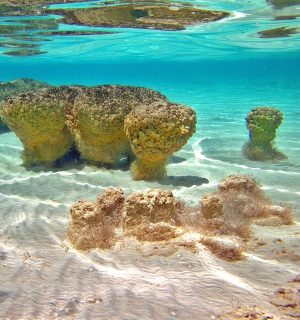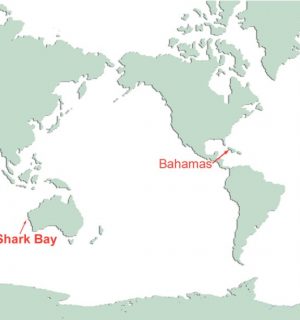Stromatolites
Stromatolites and microbial mats
Description

Microbial mats and stromatolites are diverse and complex ecosystems where different species of bacteria and other microbes work together in communities that depend upon each other. In certain conditions the communities trap particles and create stone. When this happens, microbial mats become microbialites. Sometimes microbialites form taller, layered structures called stromatolites.
Habitat

Sand and seagrass banks comprising Hamelin Pool’s northern boundary make it extremely salty by restricting water flow. It is also very hot and exposed. As most plants and animals cannot tolerate these extremes, the pool’s microbial communities have few competitors or predators to limit their numbers and that is why they are so numerous in Hamelin Pool.
Growth

The shape and texture of microbial mats and microbialites is affected by exposure, and the depth and movement of water. Between high and low tide marks, structures reflect the need to cope with being under water for hours and then exposed to the air for hours. Those under the water all of the time are affected by water depth. Water movement shapes the structures.
Distribution

Stromatolites and microbial mats in the shallows of Hamelin Pool are among the most diverse in the world and show what marine ecosystems would have looked like three billion years ago. They are only found to a depth of 4 metres because some of the microbes forming them, cyanobacteria, require sunlight.
Status
Microbial mats have been around for over 75% of the Earth’s history. Over the last two billion years cyanobacteria in microbial mats influenced evolution by breathing oxygen into the atmosphere. During the mass extinction of dinosaurs, microbial mats were among the last to be affected and the first to move into niches left empty by other species.
Fact sheet
SHARK BAY
World Heritage


